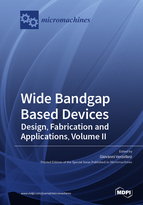Wide Bandgap Based Devices: Design, Fabrication and Applications, Volume II
A special issue of Micromachines (ISSN 2072-666X). This special issue belongs to the section "D1: Semiconductor Devices".
Deadline for manuscript submissions: closed (31 August 2021) | Viewed by 73616
Special Issue Editor
Special Issue Information
Dear Colleagues,
Emerging wide bandgap (WBG) semiconductors hold the potential to advance the global industry in the same way that, more than 50 years ago, the invention of the silicon (Si) chip enabled the modern computer era. SiC- and GaN-based devices are starting to become more commercially available. Smaller, faster, and more efficient than their counterpart Si-based components, these WBG devices also offer a greater expected reliability in tougher operating conditions. Furthermore, in this framework, a new class of microelectronic-grade semiconducting materials that have an even larger bandgap than the previously established wide-bandgap semiconductors, such as GaN and SiC, have been created, and are thus referred to as “ultra-wide-bandgap” materials. These materials, which include AlGaN, AlN, diamond, Ga2O3, and BN, offer theoretically superior properties, including a higher critical breakdown field, higher operation temperatures, and potentially higher radiation tolerance. These attributes, in turn, make it possible to use revolutionary new devices for extreme environments, such as high-efficiency power transistors, because of the improved Baliga figure of merit, ultra-high voltage pulsed power switches, high efficiency UV-LEDs, and electronics.
After the success of the first edition edited by Dr. Farid Medjdoub, a second volume of the Special Issue “Wide Bandgap Based Devices: Design, Fabrication and Applications” is being launched, aiming to collect high-quality research papers, short communications, and review articles that focus on wide bandgap device design, fabrication, and advanced characterization. In particular, the following topics are addressed:
– GaN- and SiC-based devices for power and optoelectronic applications
– Ga2O3 substrate development and Ga2O3 thin film growth, doping, and devices
– AlN-based emerging material and devices
– BN epitaxial growth, characterization, and devices
Prof. Dr. Giovanni Verzellesi
Guest Editor
Manuscript Submission Information
Manuscripts should be submitted online at www.mdpi.com by registering and logging in to this website. Once you are registered, click here to go to the submission form. Manuscripts can be submitted until the deadline. All submissions that pass pre-check are peer-reviewed. Accepted papers will be published continuously in the journal (as soon as accepted) and will be listed together on the special issue website. Research articles, review articles as well as short communications are invited. For planned papers, a title and short abstract (about 100 words) can be sent to the Editorial Office for announcement on this website.
Submitted manuscripts should not have been published previously, nor be under consideration for publication elsewhere (except conference proceedings papers). All manuscripts are thoroughly refereed through a single-blind peer-review process. A guide for authors and other relevant information for submission of manuscripts is available on the Instructions for Authors page. Micromachines is an international peer-reviewed open access monthly journal published by MDPI.
Please visit the Instructions for Authors page before submitting a manuscript. The Article Processing Charge (APC) for publication in this open access journal is 2600 CHF (Swiss Francs). Submitted papers should be well formatted and use good English. Authors may use MDPI's English editing service prior to publication or during author revisions.
Keywords
- wide bandgap devices (WBG)
- ultra-wide bandgap devices (UWBG)
- power
- optoelectronic
- GaN
- Ga2O3
- AlN
- SiC
- BN
Related Special Issues
- Wide Bandgap Based Devices: Design, Fabrication and Applications in Micromachines (21 articles)
- Wide Bandgap Based Devices: Design, Fabrication and Applications, Volume III in Micromachines (15 articles)
- Wide Bandgap Based Devices: Design, Fabrication and Applications, 4th Edition in Micromachines (2 articles)







